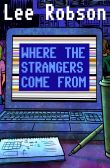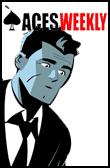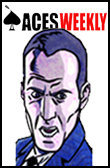This is not a post about said controversy, nor is it a personal attack on Alan Moore; I realise he's essentially become the industry's straw man, and it's incredibly easy to take a pop at him and lay various things at his door (especially after some of the interviews he's given recently), but that's not what this is about. Rather this is a post about various observations I've made after reading the first two issues. Now, I'm sure that someone's already had similar thoughts and posted similar blogs, and I probably won't be treading any new ground here, but, hey, this is the Internet and there aren't enough people on it sharing their ill informed opinions.

It was after watching David Smart's video analysis of #1, posted on Bleeding Cool, that something took hold in my mind. As good as the analysis is, it's flawed simply because it misses out two key factors that make a big difference to the story we're reading. The first is that it's a sequel to The Courtyard, a Lovecraft inspired tale from Moore that was adapted into comic form by Antony Johnston and Jacen Burrows, and published by Avatar; this explains - to some degree - the bizarre dome that's set over the city. The second major flaw is that it completely ignores the entire Lovecraft angle of the story (which plays a major role, but we'll come to that later). However, the central argument of David's video is, I think, sound, that these characters are unaware that they're characters in a comic - although, I'd go as so far to argue that they're unaware that they're characters in a work of fiction, and not just a comic.
If you go back and re-read #1, you'll notice that each and every character portrayed in it is a two dimensional cut-out, a walking, talking trope. We have the "evil serial killer" behind the glass, the senior FBI agent who was his victim, the good looking black guy, the good looking blonde agent. The one thing that binds them all is that they have no distinguishing characteristics. This is not an attack on Moore's characterisation, I have to point out, but rather it's me saying that he's being a bit of a clever bastard and dropping the first, very subtle hints that these are indeed characters in a work of fiction, but who remain unaware of their true nature. Admittedly, Agent Brears line about this being like one big, literary in-joke, should serve as a slightly less subtle hint.
It's those last two characters, our two central leads, that we have to pay particular attention to. Look at them again:

They're both young and attractive, compared to the other major characters around them. This is a standard Hollywood [and mainstream comic] idea: cast attractive leads to keep people watching. This becomes more evident in #2, just before the controversial scene:

They're both slim, in great shape, and very sexy individuals. But, I bet you can't name a single defining character trait for either of them, something that makes them stand out in your mind. Go on, try...
Once you realise what Moore's done with the characters, things begin to fall into place a little more, and begin to add fuel to the argument that these are characters who don't know they're trapped in a fictional, two dimensional world.
Moore is clearly using standard fictional tropes here to tell the story/make a statement. I remember watching Moviedrome on BBC 2 way back when Alex Cox presented it, and he pointed out one of the universal tropes of mainstream Hollywood movies (one that's still, sadly, in place now): the black characters always die first.
Moore brings this into play when he has Agent Lamper killed off during the orgy scene - he even uses a standard storytelling trick, and brings into play some wafer thin characterisation earlier in the issue, by having Lamper mention his wife, and try to instil some kind of emotional resonance to his death:

It's worth noting that, in that scene, Moore utilises another standard fictional trope: "The Pope In The Pool", where you're given a lot of exposition, but are distracted by something else as it rolls out. In this case, we get a lot of background about the works of HP Lovecraft and others, but we're distracted by Brears getting undressed.
We're seeing bare bones storytelling here, with Moore using accepted tricks that any and all writers use to to tell the story, and blatantly showing them to us as he goes to hammer home the point that this is fiction.
However, it's Agent Brears where Moore begins to add extra layers of metatext.
Now, I should warn you that from here on in, this post will become incredibly contentious and offensive to certain people, so if you're easily offended, stop reading now.
Agent Merril Brears is, as you can plainly see from the pages of the comic, a slim, attractive, blonde; she's intelligent, she wears glasses and she's witty. It's worth noting that in Moore's original script (as published in the Neonomicon Hornbook), he calls for Brears to be a fairly unremarkable woman, but Burrows clearly draws her as a pretty woman, because, hey, all fiction has to have an attractive lead. However, Brears is also a recovering "sex addict", and has no distinct personality traits. Moore is giving the reader the perfect "comic babe", essentially.
To add fuel to that fire, he has her dress like a "punk" in the first issue, and then has her dressing up in stockings, suspenders and a ridiculously short dress in the second, before finally getting naked. Moore is taking this "perfect comic babe" and presenting her in two different costumes that would hold an appeal to comic fans, before finally giving them what they want in the full frontal nudity of the orgy scene. In the hands of a lesser artist than Jacen Burrows, however, I suspect we'd be seeing a far more idealised "comic" version of Brears, with enormous breasts and constantly striking poses that would break the back of a normal person.
We've already established that Moore is using two-dimensional cut-outs for his characters, and it becomes much more evident with the introduction of Charley:

Long hair, glasses, overweight, dodgy facial hair... He is the broadest definition of a geek, or, if you prefer, a comic fan.
He is also the character that actually commits the rape of Agent Brears.
The "geek" character gets the hot blonde girl in the only way he can: by forcing himself on her.
Is this Moore making a statement? Is he attacking fans?
As it's been pointed out in other corners of the Internet, comic shops and readers had no problem stocking a comic depicting the rape and eventual murder of Sue Dibny, so what makes this so different, other than the more graphic nature of the scene?
Sue Dibny was raped by a guy in a costume. Merril Brears was raped by a "geek".
DC, arguably, fetishised the whole thing, made it "acceptable" by having it done by an established character, and brought it into the mainstream. Now, it's almost as if there isn't a mainstream female comic character that doesn't have rape in her backstory - and this is brought home by the utterly crass way that Kevin Smith did it in his Black Cat mini-series for Marvel. It makes me almost physically sick to type this, but rape has become a very quick way to add texture and meaning to a female character's background. It has become another fictional trope.
However, in Neonomicon, Moore presents rape for what it is: an unambiguously awful act of torture and depravity.
The scene is uncomfortable to read, of that there's no doubt, but when you realise who Moore has commit the actual act, it becomes even more uncomfortable for some readers out there (although, reading the scene through, you realise that Moore throws in a little something extra for those sick fucks who may have been getting off on it: Charley is willingly sodomised as he forces himself on Brears).
I don't for one second believe that Moore has added this purely for shock value, and I don't believe he's forcing his own views or "bizarre sexual philosophies" onto readers. This serves a purpose to the story as a whole, because, as I said, the rape of a female character is a fictional trope, one that people are disturbingly comfortable with.
Moore is using this in that context, but he's making damn sure that we know this is something that happens in the real world and should never be presented in any stylised or fetishised way on the comic page.
Now that you're all suitably uncomfortable, let's move this back to something else that was mentioned above: the Lovecraft angle.

The works of HP Lovecraft play a significant role in Neonomicon, and it's a mistake to ignore it. Lovecraft's stories and Cthulhu mythos have themselves become fictional tropes and standards; a lot of writers draw on them and incorporate various aspects of it into their own works (Hellboy, anyone?). Moore blatantly references Lovecraft stories through the course of the narrative of the first issue (the band, The Rats In The Malls is clearly a play on The Rats In The Walls, while the lead singer, Randolph Carter, is a direct reference to The Statement Of Randolph Carter, and the chapter titles are plays on two Lovecraft stories, At The Mountains Of Madness and The Shadow Out Of Time - and do I even need to point out that the title of the series is a play on Necronomicon?).
However, by the second issue, Moore pulls the rug out from under us and has the characters come to the same realisation, adding another layer to the metafictional narrative that's building, and perhaps giving the characters the first clue that they're nothing but characters in someone's narrative.
If Moore continues to use standard fictional tropes for the rest of the story, then the very first page of issue 1 could well hold the clue to how the story will unfold:

Is Moore planning on using the ultimate trope? Will this be revealed to have all been a dream in the final issue? And if so, whose dream?
I have my suspicions...
You can buy the Neonomicon collection here:













